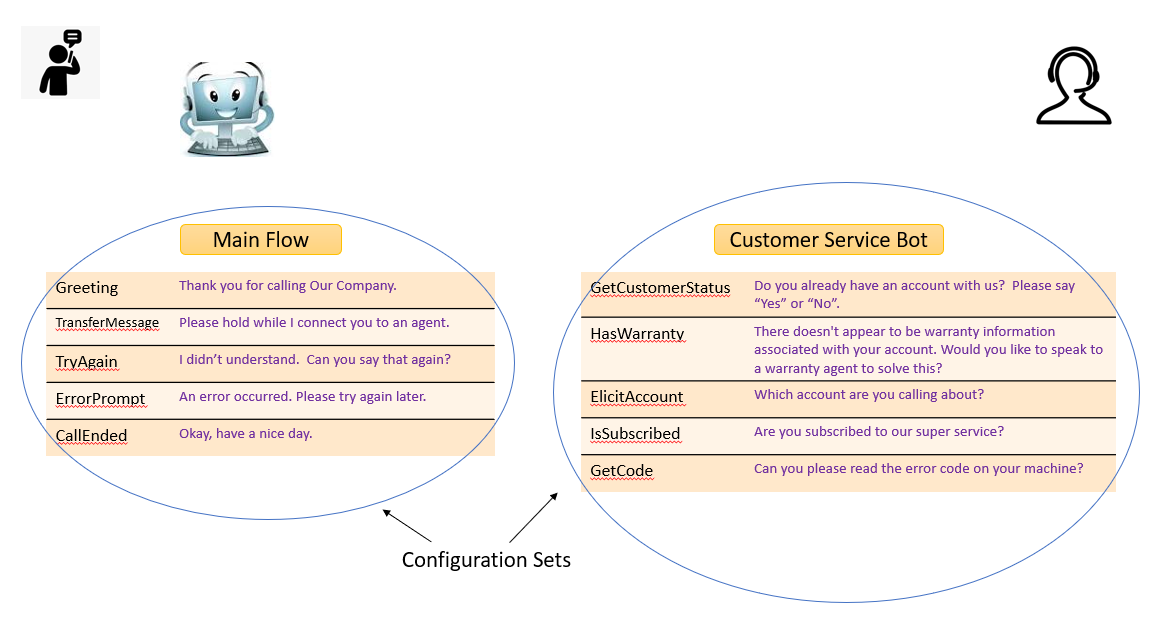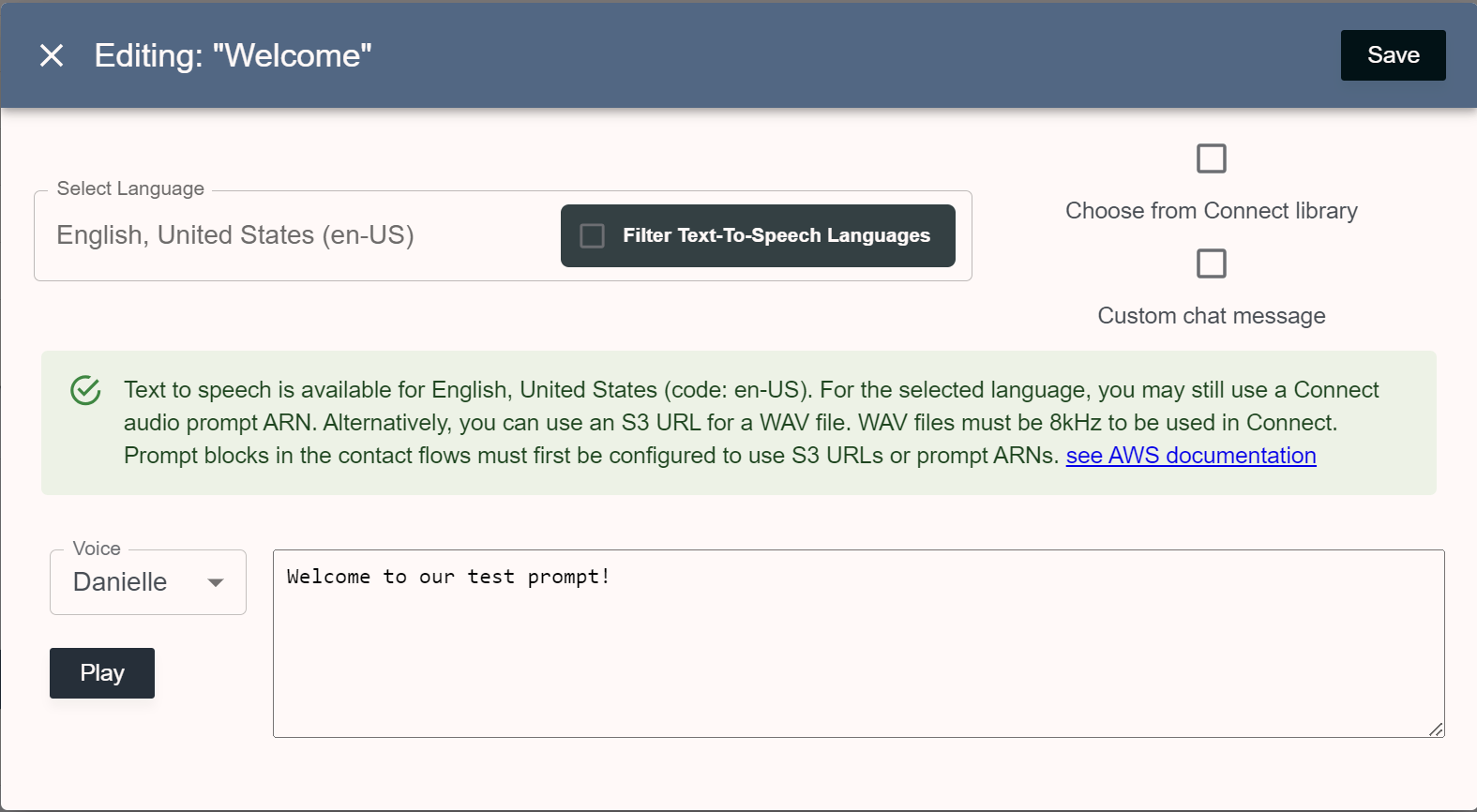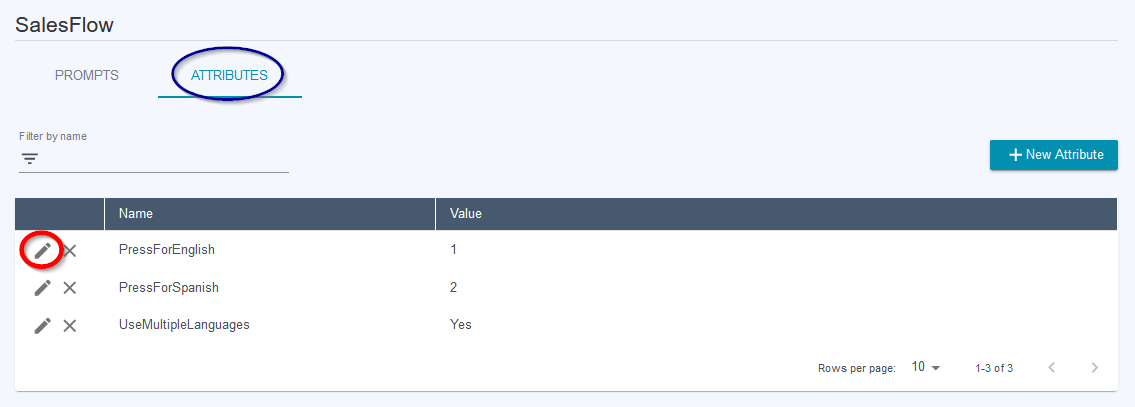Configuration Set
A Configuration Set it a group of Prompts and Attributes that are used for a Contact Flow or Lexbot. Generally, these will be created by those creating the contact flows, but there will be times when prompt text needs to be updated or a translation needs to be added, so this section will go over updating Configuration Sets and their values.

The page will display all of the Configuration Sets that have been created.

A new Configuration Sets can be created with the New Configuration Set button, but this would need to be coordinated with changes being made to Contact Flows.
To view the Prompts and Attributes, Click on a Name and the data will be displayed in the table below.
The distinction between a Prompt and an Attribute is that:
An Attribute is a simple (Name, Value) pair.
A Prompt is a Name that can have many values that are identified by their language:
(Name, (en-US: Value, fr-CA: Valeur, es-US: Valor) )
Prompts
The see the prompts for a Configuration Set, click on the Prompts tab and you will see a list of Prompts that have been defined for this Configuration Set.
New prompts can be created by clicking the New Prompt button and giving them a unique name, but these need to be coordinated with changes made to the Contact Flows.

To see all the translations defined for the Prompt, click the Down Arrow next to the Prompt Name and the prompt values will appear under the Added Languages heading.
To add a new translation, click the New Language button. You will have the opportunity to select the language, and add the translated text into the textbox.

Attributes
Attributes are found by clicking on the Attributes tab. You’ll see the list of attributes that have already been defined for the Configuration Set.
To add a new attribute, you can click the New Attribute button, but any additional attributes need to be coordinated with changes to Contact Flows.

To edit an attribute value, click the Edit icon next to the prompt name and the Edit Attribute window will open.
Only the value can be edited.
Once the attribute name is saved it cannot be changed.
Changes in attribute values may affect Contact Flow functionality, so be sure that these are also coordinated with changes to Contact Flows.

GetConfig Lambda Reference
To access Configuration Sets within a contact flow, you must use the getConfig lambda
Parameters
name: The configuration set namelang: polly language codekey?:Optional. If provided, the lambda will return the specified attribute or prompt as
{"value": "the result"}This is useful when you would like to retrieve a config set key based on a contact attribute.
CODEname: some-config lang: en-US key: $.Attributes.queueName
type?:attributes|promptsOptional. If provided, lambda will either return only attributes or prompts.
This is useful if your config set response exceeds the lambda response size limit. Ideally, you should split your config set into smaller ones, but this parameter
v8.24.0+
startsWith?:Optional. If provided, will filter keys by prefix
v8.24.0+
Outputs
name/value pairs for all attributes and prompts (for the given language).
The prompt value can be TTS text or a prompt ARN
Example
CODE{ "promptName": "Hello, welcome to ...", "promptName2": "arn:aws:connect:eu-west-2:111111111111:...", "attribute1": "value" "attribute2": "value2" … Etc }
Default Config Set
Available in OMP v8.16.0 - 2024-07-29
You can create a default config set named “SYS_Default”. The data from this config set will be automatically inherited by every other config set.
NOTE: Be careful when removing entries from the default config set. Removing an entry will automatically remove it from all config sets which do not have an override.
Example
SYS_Default
greeting: “Thank you for calling ACME Corp”
tryAgain: “I do not understand, can you repeat that?”
callEnded: “Have a nice day!”
Accounting
greeting: “You have reached the Accounting Department”
queueName: “ACCT”
When you call the getConfig lambda, you get the following response
getConfig(name: Accounting, lang: en-US)greeting: “You have reached the Accounting Department”
tryAgain: “I do not understand, can you repeat that?”
callEnded: “Have a nice day!”
queueName: “ACCT”
